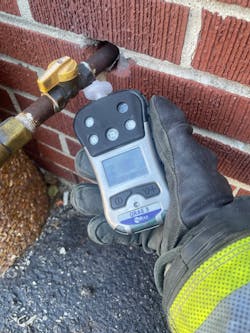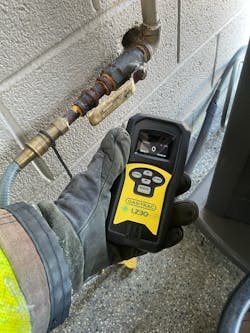For those of us who live in the north, attending to winter emergencies brings challenges that aren’t prominent in the warmer summer months or in the southern states. These challenges come in the form of PPE, tactics and responses. The latter includes an increase in gas investigations.
Gas emergencies
During warmer weather, many emergencies that involve natural gas happen outside. These typically result when gas lines are damaged by homeowners or construction crews. These emergencies frequently are handled with little or no fanfare: Fire companies stand by in a defensive status as they await the gas company’s arrival; upon arrival, the gas company crimps off the line or closes a valve; everyone then quickly packs up and returns in service.
However, as cold weather arrives in various parts of the country, gas investigations increasingly occur inside: Residents begin to heat their home with their furnace for the first time in months, or a cozy evening is planned next to the gas fireplace, unknown whether the flue is blocked, perhaps by an abandoned bird’s nest.
During these gas investigation responses, fire companies should monitor the environment for both natural gas (with mercaptan) and carbon monoxide (CO). This procedure can be accomplished by using the proper device and techniques.
Natural gas
Natural gas is the prominent gas that’s used for providing a safe, dependable, clean fuel source to cook and to heat homes and businesses. In its natural state, it’s a colorless, odorless gas that’s lighter than air. It’s made of a mixture of gases, including methane (primarily), propane, butane and carbon dioxide. Because of this mixture, the principle chemical characteristics of natural gas are a bit different than pure methane, although they are very close.
In residences and businesses, there are many sources of a potential gas leak. Ovens and ranges that are in the kitchen, hot water heaters, gas fireplaces, furnaces and boilers all can be a source of a gas leak. Fortunately, these devices can be located and accessed quickly by firefighters, and they are easy to shut off by firefighters once they are located.
Gas investigations also can occur when residents make poor decisions about heating their home with the burners that are on the kitchen range or the heat from an open oven door. This extremely dangerous practice results in a large amount of incomplete combustion, and that produces CO in high quantities. This inappropriate practice also is a source of open flames, which can cause burns or start fires.
Responding to a report of a gas leak, firefighters must be prepared to wear the appropriate gear, including structural firefighting gear, including SCBA. Injuries have occurred to firefighters from a natural gas explosion specifically when they weren’t dressed properly for the response. It’s important for firefighters to not become complacent in responding to these types of calls.
While conducting a natural gas investigation, firefighters should ask the resident whether they turned on the furnace for the first time or were cooking recently. Be certain to meter at different locations within the structure that could be the source of the leak. Measure low and high within the space to determine whether the gas is rising or staying low to the ground based on the vapor density compared with the air.
Odorants in natural gas
Most initial reports that are received of a gas leak in a home occur when the residents smell the gas leak. In fact, we can’t “smell” natural gas at all. Residents smell an odorant (a chemical additive). Methanethiol (methyl mercaptan) is called commonly by its chemical classification, mercaptan.
Mercaptans are a classification of chemicals that contain a carbon chain (R) and a sulfide group (S) at the end of the carbon chain and finish off with a hydrogen (H)—hence, R-S-H. Methyl mercaptan is selected as an additive to the odorless natural gas because of its pungent odor, which is caused by the sulfide functional group and its low odor threshold (0.002 parts per million). This creates a rotten egg, or sewer-gas-type, smell.
The olfactory system, once saturated, quickly shuts down to avoid the noxious smell, implying that a threat no longer is present in the environment. The loss of the smell of mercaptan shouldn’t be taken as proof that the gas stopped leaking but rather that we have been in the area for too long.
Carbon monoxide
CO is a byproduct of incomplete combustion when there isn’t enough oxygen present, which occurs in virtually all combustion. CO is a colorless, odorless gas that binds very easily with our hemoglobin, which are the blood cells that are responsible for carrying oxygen to our tissue. In fact, CO binds 210 times easier to hemoglobin than oxygen does, so it blocks the blood’s capability of carrying oxygen to the body’s tissue. This can be lethal if not treated.
Fire companies should get into the practice of always metering for CO concurrently while conducting a natural gas investigation.
Most frontline fire companies respond to gas emergencies with a four-gas meter. This single device typically monitors for oxygen, hydrogen sulfide, explosive/flammable limits and CO. This capability is more than suitable for a gas investigation.
Some fire companies might find themselves with a “sniffer”-type single-gas detector. These devices typically have a flexible neck on the sensor, which allows for positioning in various ways to investigate behind appliances, in drop ceilings and in low spaces. Although some of these devices provide values in the presence of gas, some simply emit a sound dependent on the quantity of gas that’s present—a lower pitch for less gas and a higher pitch for more gas.
Another type of detector that’s emerged uses a laser to detect the presence of gas in the atmosphere. These devices typically have a maximum working range of about 100 feet. The laser can pass through some glass to detect gas inside of a home, which is a very good feature. However, when the laser passes through the atmosphere and the gas, it isn’t necessarily known where the gas leak is, so it might be difficult to detect the exact location of a gas leak.
It’s important for firefighters to know what gases that their meter is calibrated for. If these meters are used to investigate a gas leak for propane or acetylene, for example, a correction factor to the value that’s displayed by the meter should be applied. This correction factor might cause the firefighter to be in the explosive range instead of safely below it.
Preparation
Firefighters should be prepared for gas investigations as part of their routine duties. Having the right PPE, knowing where to find gas leaks inside of a structure, proper meter selection and good metering techniques will prepare frontline companies for these investigations. Developing an understanding of meters’ capabilities help firefighters to make sound tactical decisions for public safety when the weather turns cold.
Quick Action Steps for Gas Investigations
Although a gas investigation might seem complex, and meters might seem difficult to use for new firefighters, responses for gas leak investigations can be simplified. Consider this list when responding to gas investigations:
- Do I have the right PPE?
- Do I have the right meter for the gas of interest?
- What gas is the meter calibrated for? (Do I need correction factors?)
- What is the alarm limit for my gas?
- How long does it take my meter to alarm?
- What actions must I take if I get an alarm?
- Where is the gas located in the building?
- Where is the gas located in the room?
- What actions must I take to stop the gas leak?
- Who do I notify if I get an alarm?
About the Author

Patrick Jessee
Patrick Jessee is the commander/paramedic for the Bureau of Operations of the Chicago Fire Department, serving on the staff of the Deputy Fire Commissioner of Operations. In his 22 years with the department, he has contributed to public safety in a variety of leadership and operation-level roles, including EMS, fire suppression and rescue, and special operations (technical rescue and hazmat). Jessee also serves as the Hazardous Materials Training Program Manager for the Northeastern Illinois Public Safety Training Academy. He holds graduate degrees in public policy and administration, threat and response management, and biology as well as undergraduate degrees in biology and chemistry. Jessee is a Certified Emergency Manager with the International Association of Emergency Managers.

